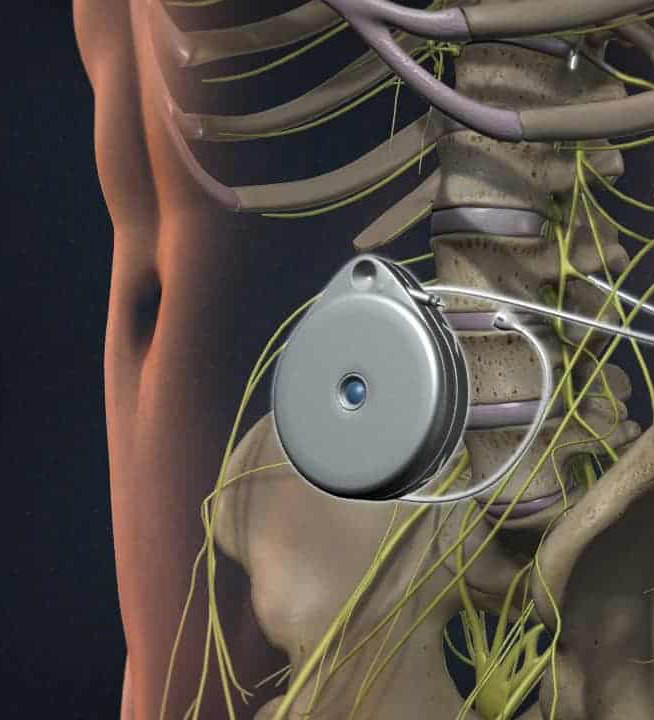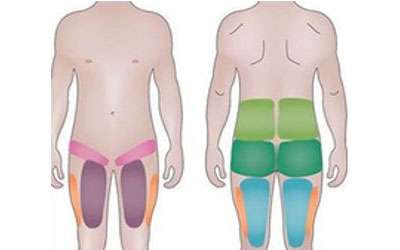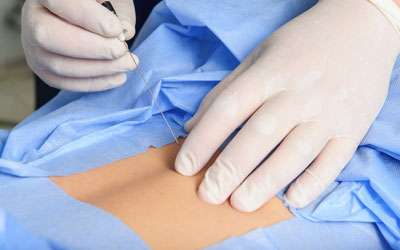Cancer Related Procedures (Intrathecal Pump)
What are Intrathecal Pumps?
An Intrathecal Pump’s delivery device implantation is an advanced interventional pain management procedure. This device is used to ease pain by delivering pain medications straight to the spinal cord, where the drug action takes place. A reservoir which holds the pain medications is inserted under the skin of your abdomen. A spinal catheter that is connected to the reservoir delivers the drugs to the spinal canal which houses the spinal cord.
As the medications are delivered directly to the site of action, only a small amount is needed for the same effect. This helps in reducing medication related side effects. This can be refilled from time to time by inserting a small needle through the skin. The pumps are replaced once every 5-7 years. This method is commonly used for spasticity management and cancer related pain or if given medication is not effective enough or has harmful side effects.
The pump is programmed to deliver a combination of medications either as a continuous infusion or as programmed intermittent doses. This is reviewed by your physician regularly and titrated to provide you with adequate pain relief. The microchip in the device has all the activities logged which can be reviewed to ensure safety. This will be checked every time the pump is refilled or if needed earlier.

What happens before the procedure?
You may be scheduled for medical scans before the procedure to back up the fact that the certain procedure is necessary. There will be some paperwork for you to sign. You will be admitted to the hospital the morning the procedure will take place. Eating or drinking past midnight is not permitted for the surgery. Before the procedure, the anaesthesiologist will go through and explain the effects of anaesthesia and its risks.
The trial tests
Figuring out whether an intrathecal pump is the best pain management option for you is a complex and key step towards your result. This is why you must undergo a trial before a permanent pump can be implanted to see if the device actually decreases your level of pain. One of the following screening tests will be necessary for you to do:
1. Single injection: You will receive one injection of the pain medicine used for an intrathecal pump (morphine or baclofen) through a lumbar puncture
2. Multiple injections: You will receive multiple injections over a series of times by lumbar puncture or catheter.
3. Continuous trial: An external pump is attached to a catheter that is then placed in the spinal canal. The pain medication dose is then increased every 2 hours until signs of pain relief is recognised.
The drug type and dose are found out through this trial testing and the best location for the catheter is also found out by the doctor. If this trial is successful, then you will be scheduled for the permanent pump procedure.
What happens during the procedure?
Your procedure will take 1-3 hours to complete. General anaesthesia will be given to you prior to the procedure commences. Once you’re sleeping, the doctor will make an incision into your abdomen, which is where your intrathecal pump will be placed. The doctor will also make an incision into your back to make way for the catheter.
The end of the catheter will be placed in the spinal canal. The other end of the catheter will be attached to the pump so that pain medication can be given through the pump into the spinal canal. Finally, the incisions will be stitched together.
The incisions may cause pain post-surgery. A prescription for pain medication will be given before you leave the hospital to reduce this pain. The doctor will talk to you regarding side-effects of the medicine and when to switch to over-the-counter pain medications. You then must stay in hospital for around 2-3 days as the doctor will plan the type and amount of medication needed to manage your pain.
Activities after your surgery
After the surgery, you will wake up in a recovery room. Your blood pressure, heart rate, and breathing will be monitored, as well as your pain. Majority of our patients are discharged home within a few days (2-3). Written instructions will be given to you after you are discharged from the hospital.
Discharge instructions
Discomfort
● Take the pain medication as prescribed by the doctor. Narcotics may be addictive and so are only used for a short period of time.
● These medications may also cause constipation. Therefore, water and high-fibre foods are recommended to consume on a daily basis. Laxatives may be needed.
● Apply ice on your incision 3-4 times per day for around 15-20 minutes to reduce pain and swelling.
● Headaches may be caused by the leakages of cerebrospinal fluid. This leak will eventually heal naturally. Lie flat and drink caffeinated, non-carbonated fluids such as tea and coffee when these headaches occur.
For about 6 to 8 weeks after your surgery, the body needs to heal and avoid performing tasks such as:
● Lifting anything weighing more than 4 kilograms
● Bending your back
● Twisting your body
● Exposing your body to extreme hot or cold temperatures
Your pain doctor will talk about when you can go back to your normal general activities
Activities:
● Don’t sit for extended periods of time
● Get up and walk 5-10 minutes every 3-4 hours. If possible, increase your walk time
Bathing/Incision Care
● Wash your hands before and after cleaning your incision
● You should shower the day after surgery if possible
● Gently wash the incision with soap and water. Inspect and wash the cut daily and dry by patting the incision on a towel rather than rubbing it
● Do not submerge the incision in water
● Do not apply any ointments or moisturisers over and around the incision area
● Small amounts of drainage from the incision is normal. However, a large amount of drainage, foul smelling drainage, or drainage that is yellow or green in colour should be reported to your doctor’s office immediately.
● Fluid may accumulate under the skin around the leads or the device, creating a visible swelling. Notify the doctor’s office if this occurs.
When to Call Your Doctor
● Fever with a temperature over or the same as 38.5 degrees celsius
● Continuous nausea or pain
● If unanticipated back pain, unexpected onset of leg weakness and spasm, loss of bladder and/or bowel function occurs, call an emergency service immediately. Get to a hospital and call for your pain doctor
● If your headache lasts over 48 hours (2 days).
What are the risks?
There are minimal side effects for intrathecal drug pumps, however, there are some. Complication may include infection and bleeding as with all procedures and surgeries. The catheter may also move or be obstructed on rare occasions. Cerebrospinal fluid may leak or accumulate, causing a clear fluid discharge from your incisions or a headache. These repercussions usually disappear naturally, but may require to be drained. If the device is infected, ineffective for relieving pain or is misused, the device will be removed.
Side-effects from over/under-dosing the pain medications may include respiratory depression, twitching, muscle spasm, urinary retention, constipation, nausea, vomiting, dizziness, anxiety, depression, and edema.
The battery also needs to be replaced every 5 to 7 years, depending on the amount of medication pumped.
What are the results?
You will experience a great reduction in pain that will help in creating changes in daily activities and living.
– Shoulder and upper limb pain
– Chest pain
– Abdominal pain
– Pelvic Pain
– Pain management programs
Cancer Related Procedures (Intrathecal Pump)
What are Intrathecal Pumps?
An Intrathecal Pump’s delivery device implantation is an advanced interventional pain management procedure. This device is used to ease pain by delivering pain medications straight to the spinal cord, where the drug action takes place. A reservoir which holds the pain medications is inserted under the skin of your abdomen. A spinal catheter that is connected to the reservoir delivers the drugs to the spinal canal which houses the spinal cord.
As the medications are delivered directly to the site of action, only a small amount is needed for the same effect. This helps in reducing medication related side effects. This can be refilled from time to time by inserting a small needle through the skin. The pumps are replaced once every 5-7 years. This method is commonly used for spasticity management and cancer related pain or if given medication is not effective enough or has harmful side effects.
The pump is programmed to deliver a combination of medications either as a continuous infusion or as programmed intermittent doses. This is reviewed by your physician regularly and titrated to provide you with adequate pain relief. The microchip in the device has all the activities logged which can be reviewed to ensure safety. This will be checked every time the pump is refilled or if needed earlier.

What happens before the procedure?
You may be scheduled for medical scans before the procedure to back up the fact that the certain procedure is necessary. There will be some paperwork for you to sign. You will be admitted to the hospital the morning the procedure will take place. Eating or drinking past midnight is not permitted for the surgery. Before the procedure, the anaesthesiologist will go through and explain the effects of anaesthesia and its risks.
The trial tests
Figuring out whether an intrathecal pump is the best pain management option for you is a complex and key step towards your result. This is why you must undergo a trial before a permanent pump can be implanted to see if the device actually decreases your level of pain. One of the following screening tests will be necessary for you to do:
1. Single injection: You will receive one injection of the pain medicine used for an intrathecal pump (morphine or baclofen) through a lumbar puncture
2. Multiple injections: You will receive multiple injections over a series of times by lumbar puncture or catheter.
3. Continuous trial: An external pump is attached to a catheter that is then placed in the spinal canal. The pain medication dose is then increased every 2 hours until signs of pain relief is recognised.
The drug type and dose are found out through this trial testing and the best location for the catheter is also found out by the doctor. If this trial is successful, then you will be scheduled for the permanent pump procedure.
What happens during the procedure?
Your procedure will take 1-3 hours to complete. General anaesthesia will be given to you prior to the procedure commences. Once you’re sleeping, the doctor will make an incision into your abdomen, which is where your intrathecal pump will be placed. The doctor will also make an incision into your back to make way for the catheter.
The end of the catheter will be placed in the spinal canal. The other end of the catheter will be attached to the pump so that pain medication can be given through the pump into the spinal canal. Finally, the incisions will be stitched together.
The incisions may cause pain post-surgery. A prescription for pain medication will be given before you leave the hospital to reduce this pain. The doctor will talk to you regarding side-effects of the medicine and when to switch to over-the-counter pain medications. You then must stay in hospital for around 2-3 days as the doctor will plan the type and amount of medication needed to manage your pain.
Activities after your surgery
After the surgery, you will wake up in a recovery room. Your blood pressure, heart rate, and breathing will be monitored, as well as your pain. Majority of our patients are discharged home within a few days (2-3). Written instructions will be given to you after you are discharged from the hospital.
Discharge instructions
Discomfort
● Take the pain medication as prescribed by the doctor. Narcotics may be addictive and so are only used for a short period of time.
● These medications may also cause constipation. Therefore, water and high-fibre foods are recommended to consume on a daily basis. Laxatives may be needed.
● Apply ice on your incision 3-4 times per day for around 15-20 minutes to reduce pain and swelling.
● Headaches may be caused by the leakages of cerebrospinal fluid. This leak will eventually heal naturally. Lie flat and drink caffeinated, non-carbonated fluids such as tea and coffee when these headaches occur.
For about 6 to 8 weeks after your surgery, the body needs to heal and avoid performing tasks such as:
● Lifting anything weighing more than 4 kilograms
● Bending your back
● Twisting your body
● Exposing your body to extreme hot or cold temperatures
Your pain doctor will talk about when you can go back to your normal general activities
Activities:
● Don’t sit for extended periods of time
● Get up and walk 5-10 minutes every 3-4 hours. If possible, increase your walk time
Bathing/Incision Care
● Wash your hands before and after cleaning your incision
● You should shower the day after surgery if possible
● Gently wash the incision with soap and water. Inspect and wash the cut daily and dry by patting the incision on a towel rather than rubbing it
● Do not submerge the incision in water
● Do not apply any ointments or moisturisers over and around the incision area
● Small amounts of drainage from the incision is normal. However, a large amount of drainage, foul smelling drainage, or drainage that is yellow or green in colour should be reported to your doctor’s office immediately.
● Fluid may accumulate under the skin around the leads or the device, creating a visible swelling. Notify the doctor’s office if this occurs.
When to Call Your Doctor
● Fever with a temperature over or the same as 38.5 degrees celsius
● Continuous nausea or pain
● If unanticipated back pain, unexpected onset of leg weakness and spasm, loss of bladder and/or bowel function occurs, call an emergency service immediately. Get to a hospital and call for your pain doctor
● If your headache lasts over 48 hours (2 days).
What are the risks?
There are minimal side effects for intrathecal drug pumps, however, there are some. Complication may include infection and bleeding as with all procedures and surgeries. The catheter may also move or be obstructed on rare occasions. Cerebrospinal fluid may leak or accumulate, causing a clear fluid discharge from your incisions or a headache. These repercussions usually disappear naturally, but may require to be drained. If the device is infected, ineffective for relieving pain or is misused, the device will be removed.
Side-effects from over/under-dosing the pain medications may include respiratory depression, twitching, muscle spasm, urinary retention, constipation, nausea, vomiting, dizziness, anxiety, depression, and edema.
The battery also needs to be replaced every 5 to 7 years, depending on the amount of medication pumped.
What are the results?
You will experience a great reduction in pain that will help in creating changes in daily activities and living.
– Shoulder and upper limb pain
– Chest pain
– Abdominal pain
– Pelvic Pain
– Pain management programs


